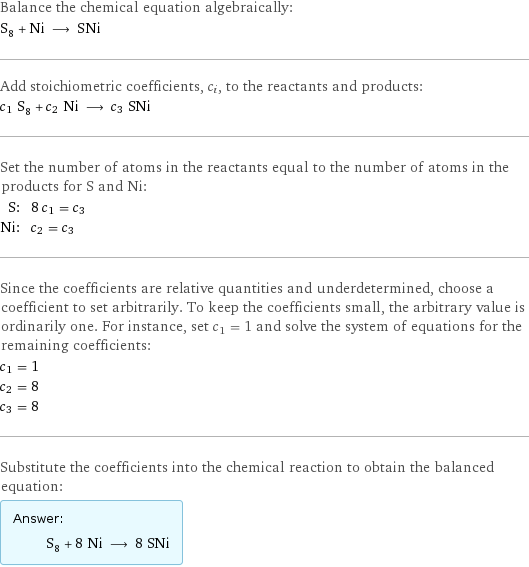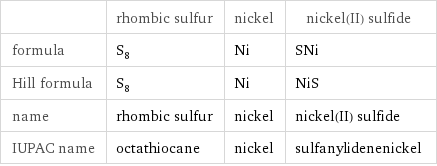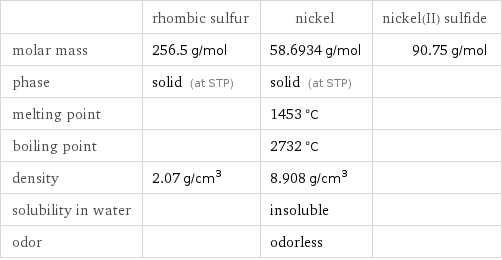Input interpretation

S_8 rhombic sulfur + Ni nickel ⟶ SNi nickel(II) sulfide
Balanced equation

Balance the chemical equation algebraically: S_8 + Ni ⟶ SNi Add stoichiometric coefficients, c_i, to the reactants and products: c_1 S_8 + c_2 Ni ⟶ c_3 SNi Set the number of atoms in the reactants equal to the number of atoms in the products for S and Ni: S: | 8 c_1 = c_3 Ni: | c_2 = c_3 Since the coefficients are relative quantities and underdetermined, choose a coefficient to set arbitrarily. To keep the coefficients small, the arbitrary value is ordinarily one. For instance, set c_1 = 1 and solve the system of equations for the remaining coefficients: c_1 = 1 c_2 = 8 c_3 = 8 Substitute the coefficients into the chemical reaction to obtain the balanced equation: Answer: | | S_8 + 8 Ni ⟶ 8 SNi
Structures

+ ⟶
Names

rhombic sulfur + nickel ⟶ nickel(II) sulfide
Equilibrium constant
![Construct the equilibrium constant, K, expression for: S_8 + Ni ⟶ SNi Plan: • Balance the chemical equation. • Determine the stoichiometric numbers. • Assemble the activity expression for each chemical species. • Use the activity expressions to build the equilibrium constant expression. Write the balanced chemical equation: S_8 + 8 Ni ⟶ 8 SNi Assign stoichiometric numbers, ν_i, using the stoichiometric coefficients, c_i, from the balanced chemical equation in the following manner: ν_i = -c_i for reactants and ν_i = c_i for products: chemical species | c_i | ν_i S_8 | 1 | -1 Ni | 8 | -8 SNi | 8 | 8 Assemble the activity expressions accounting for the state of matter and ν_i: chemical species | c_i | ν_i | activity expression S_8 | 1 | -1 | ([S8])^(-1) Ni | 8 | -8 | ([Ni])^(-8) SNi | 8 | 8 | ([S1Ni1])^8 The equilibrium constant symbol in the concentration basis is: K_c Mulitply the activity expressions to arrive at the K_c expression: Answer: | | K_c = ([S8])^(-1) ([Ni])^(-8) ([S1Ni1])^8 = ([S1Ni1])^8/([S8] ([Ni])^8)](../image_source/959648a7ea00140b2750dbb5ee1b3f2b.png)
Construct the equilibrium constant, K, expression for: S_8 + Ni ⟶ SNi Plan: • Balance the chemical equation. • Determine the stoichiometric numbers. • Assemble the activity expression for each chemical species. • Use the activity expressions to build the equilibrium constant expression. Write the balanced chemical equation: S_8 + 8 Ni ⟶ 8 SNi Assign stoichiometric numbers, ν_i, using the stoichiometric coefficients, c_i, from the balanced chemical equation in the following manner: ν_i = -c_i for reactants and ν_i = c_i for products: chemical species | c_i | ν_i S_8 | 1 | -1 Ni | 8 | -8 SNi | 8 | 8 Assemble the activity expressions accounting for the state of matter and ν_i: chemical species | c_i | ν_i | activity expression S_8 | 1 | -1 | ([S8])^(-1) Ni | 8 | -8 | ([Ni])^(-8) SNi | 8 | 8 | ([S1Ni1])^8 The equilibrium constant symbol in the concentration basis is: K_c Mulitply the activity expressions to arrive at the K_c expression: Answer: | | K_c = ([S8])^(-1) ([Ni])^(-8) ([S1Ni1])^8 = ([S1Ni1])^8/([S8] ([Ni])^8)
Rate of reaction
![Construct the rate of reaction expression for: S_8 + Ni ⟶ SNi Plan: • Balance the chemical equation. • Determine the stoichiometric numbers. • Assemble the rate term for each chemical species. • Write the rate of reaction expression. Write the balanced chemical equation: S_8 + 8 Ni ⟶ 8 SNi Assign stoichiometric numbers, ν_i, using the stoichiometric coefficients, c_i, from the balanced chemical equation in the following manner: ν_i = -c_i for reactants and ν_i = c_i for products: chemical species | c_i | ν_i S_8 | 1 | -1 Ni | 8 | -8 SNi | 8 | 8 The rate term for each chemical species, B_i, is 1/ν_i(Δ[B_i])/(Δt) where [B_i] is the amount concentration and t is time: chemical species | c_i | ν_i | rate term S_8 | 1 | -1 | -(Δ[S8])/(Δt) Ni | 8 | -8 | -1/8 (Δ[Ni])/(Δt) SNi | 8 | 8 | 1/8 (Δ[S1Ni1])/(Δt) (for infinitesimal rate of change, replace Δ with d) Set the rate terms equal to each other to arrive at the rate expression: Answer: | | rate = -(Δ[S8])/(Δt) = -1/8 (Δ[Ni])/(Δt) = 1/8 (Δ[S1Ni1])/(Δt) (assuming constant volume and no accumulation of intermediates or side products)](../image_source/fc448c6110183d14601ebca052503876.png)
Construct the rate of reaction expression for: S_8 + Ni ⟶ SNi Plan: • Balance the chemical equation. • Determine the stoichiometric numbers. • Assemble the rate term for each chemical species. • Write the rate of reaction expression. Write the balanced chemical equation: S_8 + 8 Ni ⟶ 8 SNi Assign stoichiometric numbers, ν_i, using the stoichiometric coefficients, c_i, from the balanced chemical equation in the following manner: ν_i = -c_i for reactants and ν_i = c_i for products: chemical species | c_i | ν_i S_8 | 1 | -1 Ni | 8 | -8 SNi | 8 | 8 The rate term for each chemical species, B_i, is 1/ν_i(Δ[B_i])/(Δt) where [B_i] is the amount concentration and t is time: chemical species | c_i | ν_i | rate term S_8 | 1 | -1 | -(Δ[S8])/(Δt) Ni | 8 | -8 | -1/8 (Δ[Ni])/(Δt) SNi | 8 | 8 | 1/8 (Δ[S1Ni1])/(Δt) (for infinitesimal rate of change, replace Δ with d) Set the rate terms equal to each other to arrive at the rate expression: Answer: | | rate = -(Δ[S8])/(Δt) = -1/8 (Δ[Ni])/(Δt) = 1/8 (Δ[S1Ni1])/(Δt) (assuming constant volume and no accumulation of intermediates or side products)
Chemical names and formulas

| rhombic sulfur | nickel | nickel(II) sulfide formula | S_8 | Ni | SNi Hill formula | S_8 | Ni | NiS name | rhombic sulfur | nickel | nickel(II) sulfide IUPAC name | octathiocane | nickel | sulfanylidenenickel
Substance properties

| rhombic sulfur | nickel | nickel(II) sulfide molar mass | 256.5 g/mol | 58.6934 g/mol | 90.75 g/mol phase | solid (at STP) | solid (at STP) | melting point | | 1453 °C | boiling point | | 2732 °C | density | 2.07 g/cm^3 | 8.908 g/cm^3 | solubility in water | | insoluble | odor | | odorless |
Units
